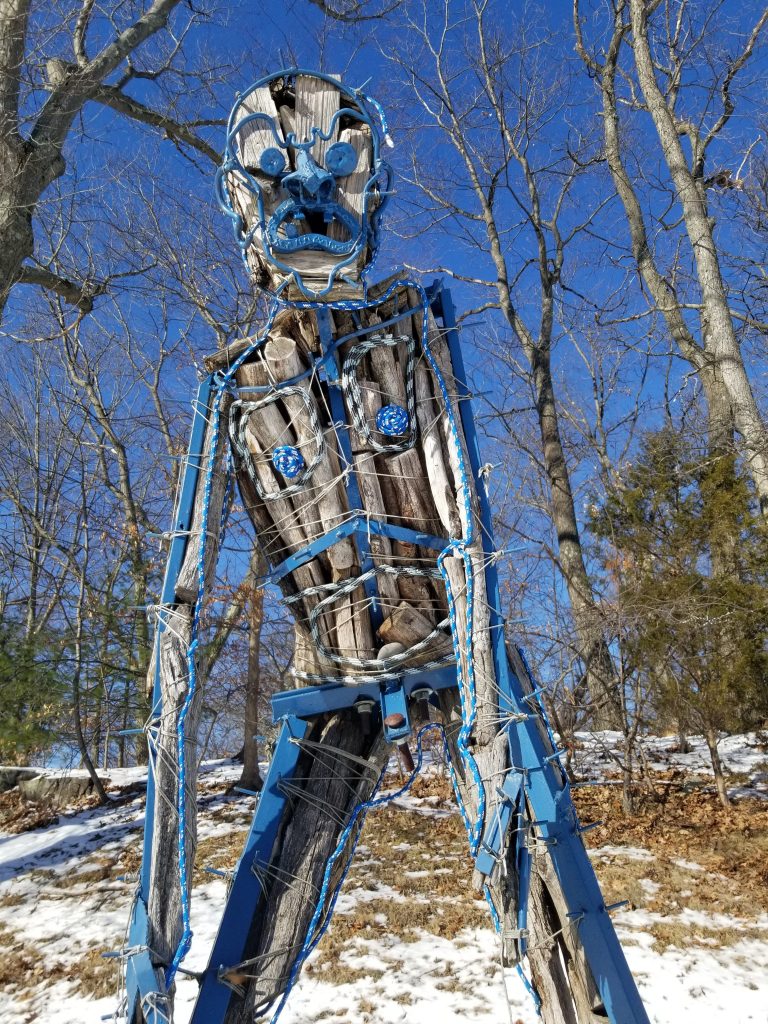There is a metal man stalking the theater building. Students of lower campus know this one well, though its history has largely been forgotten for a few years now. Created over the course of three months for the 2014 Leonard Bernstein Festival of the Arts by student artist Paul Belenkey ’14, the statue originally known as “A Golem for Brandeis University” has withstood the test of time. The golem was originally on display in the green beside Rabb overlooking the wall of stones. After the festival, it was briefly moved to the front lawn of Spingold before receiving a final relocation closer to the Rose, and it has presumably not moved since. Students and visitors these days will easily spot the golem if they follow the path from the Shapiro Campus Center (SCC) to the theater building. Standing well over six feet tall and sporting one of the most iconic phalluses on campus, our golem is hard to ignore.

According to Belenkey, the sculpture has held up surprisingly well despite nonstop exposure to New England’s climate for almost six years. In spite of its steel frame, the golem is comprised mainly of organic material: wood and rope. The chopped wood that fills out the head, limbs and body was derived from dead logs gathered throughout the campus, and these are lashed to the metal skeleton with blue and white cords to match the university’s colors. Likewise, the blue painted steel has remained untarnished over the years. Photographs from 2014 reveal that the piece was once much brighter thanks to the yellow of the freshly cut wood, but the planks of the face have since degraded into a dull brown.
The composition of the statue has lost none of its dynamism over the years. In fact, the golem appears very much alive. This is thanks in no small part to the attention Belenkey placed on the weightiness of his design. The figure is not stock upright like some kind of zombie George Washington. Rather, the figure of the golem slumps as it supports the apparent ungainliness of its massive, protruding head. The limbs are delightfully asymmetrical; one arm hangs much lower than the other, giving the torso the appearance of twisting or shifting. This sense of motion and weight is assisted by the legs, which bend. The viewer can easily imagine what this creature would look like if it could actually walk. One can almost hear the creak of the swaying arms and bending knees as the monster shuffles and slouches its way forward, head constantly, laboriously inclined in its dauntless march through the wastelands of Waltham. Even at a distance, without being able to see the grotesque shapes that make up its angry face, one can make out the intention of this golem. It is a brooding, skulking beast of adamant steel rendered in the most fluid way possible. Somebody ought to animate this thing!
With such a strongly designed presence, it is no wonder many students describe the golem as creepy. The erect metal penis certainly doesn’t help. Behind the scary exterior is a warm heart, however. During the art festival of 2014, the unveiling of the golem was celebrated with a so-called “activation ceremony.” Participants gathered in front of the Rabb steps to watch as Belenkey placed a large red heart on a chain around the golem’s neck, a symbolic gesture of granting the statue life. This is in line with the mythological connotation of the piece. In Jewish folklore, a golem is an inanimate construct given artificial life by a rabbi (a concept invented long before our modern conception of robotic android). Crude as its design may be, the sculpture comes from a place of good humor. It is like a guardian of sorts.
The heart necklace is no longer to be found on the golem—all that is left now is a facade of terror. Alas, Brandeis’s golem, like Frankenstein’s monster, is perhaps forever doomed to solitude by its own hideousness. Just last year, an art student, thinking himself very clever, stuck a wooden sword into the golem’s chest. This statement, while funny and thematically on point, misconstrues the true intent of the monster. I am sure it is actually quite sensitive.
A note about the penis: While assuredly a gag element, the member is also integral to the construction of the sculpture. Due to its immense size, the golem needed to be constructed in two parts in order to be removed from the studio. This design challenge offered Belenky the perfect opportunity to add a penis, since a third point of contact was needed in order to join the top and bottom halves of the structure at the hips. Without the extra bar of steel, the golem would not be able to stand. In short, students hoping to take down the beast should definitely aim for the groin.
At the time of writing, no information on this sculpture exists on the Internet. I had to reach out to Paul Belenkey directly in order to discover the piece’s name and year of creation. This art piece, while far from ignored, has fallen under the radar of Brandeis’s documentation. I am pleased to be the first to set the golem’s name and story into permanence. In terms of iconic campus sculptures, “A Golem for Brandeis University” stands out in my mind as the third most memorable piece of public artwork next to the castle and the statue of Louis D. himself. May the golem forever haunt the groves of Lower Campus!


